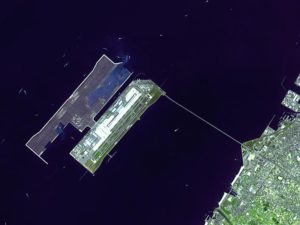Typhoon Jebi highlights risks of rising sea levels on airports
On Tuesday, September 4, Japan was hit head-on by Typhoon Jebi, the strongest typhoon to hit Japan in 25 years. The storm left 11 dead and several hundred injured, and perhaps some of its most severe damage was to Japan’s airports.

Heavy rain, along with an 11-foot storm surge that overtopped protective sea walls, left runways flooded at the Kansai International Airport. The dangerous weather conditions and flooding caused a ripple effect of cancelled flights out of Japan’s third busiest airport. To make matters worse, the strong winds, which at one point measured at over 216 kph (134 mph), blew an anchored oil tanker into the only bridge connecting the mainland to the man-made island on which the airport resides. The crash heavily damaged the roadway, leaving thousands of passengers and airport staff stranded overnight. They were eventually evacuated the next day by ferry or by bus on the few remaining undamaged lanes of the bridge. The airport was closed from Tuesday onward until it reopened with partial function on Friday.
The perils of the Kansai airport highlight the risk that many airports are facing today with a rising sea level and threat of stronger storms due to a warming climate: flooding. Like many other airports, the Kansai airport is located on a low-lying area on the coast, ideal for avoiding tall obstacles and disturbances to communities, but not so ideal for avoiding sea level rise, storm surge, and other weather related risks. Flooding can cut off runways, making it impossible to take off or land, and even when some of the runways are not flooded, it can cripple capacity and increase fuel costs by making planes wait to use the working runway. Flooding does not even have to be on the runways to incapacitate airports. If the access roads to the airports are made unusable by flooding or other damage, operations can be severely limited.
The Kansai airport in particular is in a sticky situation when it comes to coastal flooding, as it is located on top of reclaimed land that has been sinking much faster than engineers expected into the compacted clay on the seabed. But the Japanese are not about to let their infrastructure sink beneath the waves. Efforts to protect the airport include pumping water out from under the land to hasten the settlement process, constructing protective seawalls, and installing pumps that drain the airfields after heavy rain.
The Kansai airport is far from the only airport vulnerable to subsiding land and rising waters. For example, the Oakland International Airport, California’s fourth busiest airport, in 2013 was named as one of the United States’ 12 most vulnerable airports to sea level rise. It lies on top of reclaimed land created by filling in part of the San Francisco Bay’s wetlands, meaning that it is both relatively low-lying and more vulnerable to liquefaction during earthquakes. Liquefaction, where shaking causes water-saturated sediments to act like a liquid, may further exacerbate flooding by causing subsidence or by damaging the levees that protect the airport.
Incapacitated airports can have dire consequences for travel and trade, as well as for relief and recovery efforts after disasters. As airports come to face more risk from storm surge, sea level rise, and other climate change related effects, there has been a movement toward innovative solutions to increase airport resilience. “Aviation has been dealing with disruptive weather for as long as we’ve been flying,” Rachel Burbidge, the officer of environmental and climate change policy for the air traffic management organization Eurocontrol, said to Popular Science. “I certainly don’t think this is an insurmountable challenge.”
Sources and Further Readings
Japan Copes With Aftermath of Jebi, Strongest Typhoon in 25 Years – New York Times
Many Major Airports Are Near Sea Level. A Disaster in Japan Shows What Can Go Wrong – New York Times
Typhoon Jebi’s superstrong winds of over 216 kph drove tanker into Kansai airport bridge – Japan Times
In a Warming World, Keeping the Planes Running – New York Times
U.S. Airports Face Increasing Threat From Rising Seas – Climate Central
ART Vulnerability and Risk ASsessment REport Chapter 9. Airport – Adapting to Rising Tides
Here are all the ways climate change will ruin your flight – Popular Science
